Project Categories: Main Beam TBM
The Epping to Chatswood Rail Link
Обзор проекта
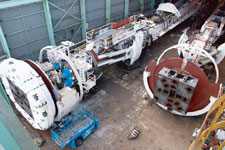
Городская железнодорожная сеть Сиднея была расширена строительством линии Эпинг – Чествуд. Проект состоял из двух параллельных тоннелей длиной по 12,5 км каждый. Правительство штата Новый Южный Уэльс присудило контракт на строительство совместному предприятию Theiss Hochtief (THJV), учрежденному австралийской и немецкой строительными компаниями.
В 2002 году подрядчик заказал Компании Роббинс две ТБМ открытого типа диаметром 7,2 м. Машины пробурили два тоннеля, начав работу от автобусной станции «Дели», расположенной приблизительно в центре трассы тоннелей. При этом были достигнуты впечатляющие скорости проходки.
Геология
Оба тоннеля проходят сквозь свиту песчаников Hawkesbury и отложения сланцев Ashfield. На трассе находится один разлом, расположенный в районе станции Macquarie Park примерно в 2 км от начала проходки первого перегона
ТБМы и конвейеры
Каждая из двух ТБМ открытого типа располагает мощностью на режущей головке в 2300 кВт и максимальным усилием подачи в 1400 метрических тонн. Компания Роббинс внесла в проект обеих машин ряд новаторских идей. Так, уникальный перекатной защитовой комплекс позволил производить укладку монолитного бетона в обратный свод тоннеля непосредственно во время бурения. Такой метод создания бетонного дорожного полотна, не останавливая проходку, позволил применить самоходное оборудование на шинном ходу и организовать быструю укладку рельсового пути.
Специально для этого проекта Роббинс создал также оригинальную конвейерную систему, состоящую из пяти работающих совместно конвейеров: двух горизонтальных, двух вертикальных и одного отвалообразователя. Смонтированный в своде тоннеля, горизонтальный конвейер работал на длине 6 км трасы тоннеля, более чем на 80% состоящей из кривых.
Проходка тоннеля
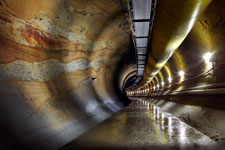 Машины начали бурение тоннелей в августе и сентябре 2003 года соответственно. Обе машины закончили проходку в Эпинге в июле 2004 года. Вторые перегоны начали бурить в ноябре 2004 года и машины пришли в Четсвуд в июне и июле 2005 года соответственно. За это время одна из машин поставила мировой рекорд скорости проходки в своём классе, пробурив за сутки 92 м тоннеля. Лучшим результатом проходки за неделю стали 368 м. Средняя недельная скорость проходки для всего проекта составила 200 м. С машинами было мало проблем и они были готовы к работе 80% общего времени строительства.
Машины начали бурение тоннелей в августе и сентябре 2003 года соответственно. Обе машины закончили проходку в Эпинге в июле 2004 года. Вторые перегоны начали бурить в ноябре 2004 года и машины пришли в Четсвуд в июне и июле 2005 года соответственно. За это время одна из машин поставила мировой рекорд скорости проходки в своём классе, пробурив за сутки 92 м тоннеля. Лучшим результатом проходки за неделю стали 368 м. Средняя недельная скорость проходки для всего проекта составила 200 м. С машинами было мало проблем и они были готовы к работе 80% общего времени строительства.
New Wuchieh Diversion Tunnel
Project Overview
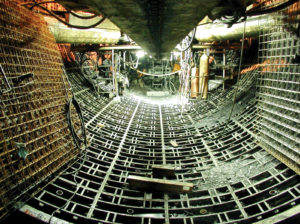 The New Wuchieh Diversion Tunnel is part of a water transfer system that feeds into the Sun-Moon Lake Hydraulic Power Plant, one of the largest single power sources in Taiwan. Project owners Taipower commissioned the new 6.3 km (3.9 mi) long tunnel after the original Wuchieh Diversion Tunnel was found cracked and degraded after 70 years of service.
The New Wuchieh Diversion Tunnel is part of a water transfer system that feeds into the Sun-Moon Lake Hydraulic Power Plant, one of the largest single power sources in Taiwan. Project owners Taipower commissioned the new 6.3 km (3.9 mi) long tunnel after the original Wuchieh Diversion Tunnel was found cracked and degraded after 70 years of service.
The tunnel stretches from its source at Sun-Moon Lake to the intake structure at the hydraulic power station. The new tunnel, along with another water transfer tunnel feeding into Sun-Moon Lake, will increase the output of the power plant to 7,600,000 KWh annually.
Taipower awarded the construction contract for the new diversion tunnel to Kumagai Gumi Co. Ltd. The contractor chose a 6.2 m (20.3 ft) diameter Robbins Main Beam TBM for the project.
Geology
The tunnel passes through quartzite, sandstone, and slate. There are also some areas containing broken rock.
TBM
Robbins rebuilt a used 6.2 m (20.3 ft) diameter Main Beam TBM for the New Wuchieh Tunnel. The refurbished TBM featured 17 inch (432mm) wedge-lock cutters and 1,890 kW (2,534 hp) of cutterhead power. The 380 tonne (420 ton) machine also generated a maximum torque of 1,774,415 N-m (1,307,550 lb-ft) at the cutterhead.
Tunnel Excavation
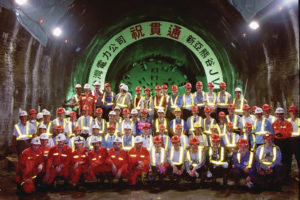 The TBM began boring in July 2000 and finished in 24 months on June 7, 2002. The TBM’s average monthly advance was over 400 m (1,312 ft) and it acheived a best month of 650 m (2,133 ft). After half of the tunnel had been excavated some broken ground was encountered and tunnel linings such as ring beams, mesh, and shotcrete were applied. Some portions of the tunnel were also lined with cast iron segments for additional support.
The TBM began boring in July 2000 and finished in 24 months on June 7, 2002. The TBM’s average monthly advance was over 400 m (1,312 ft) and it acheived a best month of 650 m (2,133 ft). After half of the tunnel had been excavated some broken ground was encountered and tunnel linings such as ring beams, mesh, and shotcrete were applied. Some portions of the tunnel were also lined with cast iron segments for additional support.
In September 2001, Typhoon Toraji hit the area and flooded the site with mud, water, and rocks. Some of the shipping containers containing spare parts, cutters, and workshops were completely submerged. Fortunately, the flood level stayed below the working tunnel level and operations were merely delayed. The remainder of the excavation went smoothly and the finished tunnel was celebrated as the first tunnel ever completed solely by TBM in Taiwan.
Little Calumet
Project Overview
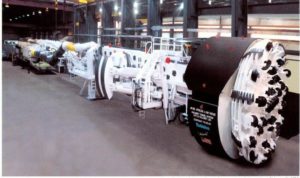 The Little Calumet Leg Tunnel is the final element in Phase 1 of Chicago’s long-running Tunnel and Reservoir Project (TARP). The project involves storm water storage, reservoirs, and feeder tunnels that have greatly improved water quality in Chicago-area Rivers. The Little Calumet Leg is part of a longer TARP tunnel system that prevents combined sewer overflows from spilling into the Little Calumet River.
The Little Calumet Leg Tunnel is the final element in Phase 1 of Chicago’s long-running Tunnel and Reservoir Project (TARP). The project involves storm water storage, reservoirs, and feeder tunnels that have greatly improved water quality in Chicago-area Rivers. The Little Calumet Leg is part of a longer TARP tunnel system that prevents combined sewer overflows from spilling into the Little Calumet River.
In 2002, the project owner, Metropolitan Water Reclamation District of Greater Chicago (MWRDGC), awarded the construction contract to the Jay Dee/Affholder Joint Venture. The two contractors split the work, with Jay Dee responsible for surface works, shallow tunnels, and shafts. Affholder was responsible for deep tunnels and TBM boring. The joint venture chose a 5.56 m (18.2 ft) diameter Robbins Main Beam TBM to bore a 12.8 km (8.0 mi) section of tunnel.
Geology
The rock consisted of Silurian age dolomitic limestone with an Unconfined Compressive Strength (UCS) of 97 – 241 MPa (14 – 35 ksi). The limestone had few faults and was considered good tunneling ground.
TBM
Robbins refurbished the Main Beam TBM specifically for the project. The machine featured 39 wedge lock 19 inch (483 mm) cutters and a cutterhead thrust of 9,101 kN (2,044,050 lb). The cutterhead was driven by seven 335.6 kW (450 hp) AC electric motors that supplied 2,350 kW (2,975 hp) of power to the cutterhead. The machine also generated 1,882,877 N-m (1,389,705 lb-ft) of cutterhead torque.
Muck was transported by a Robbins conveyor system, including an an advancing horizontal conveyor, S-type vertical conveyor, surface conveyor, and stacker conveyor.The muck was transported from the bridge conveyor on the back-up to the main horizontal conveyor. A conveyor with self-adjusting curve idlers was necessary for most of the tunnel in order to negotiate tight curves.
Tunnel Excavation
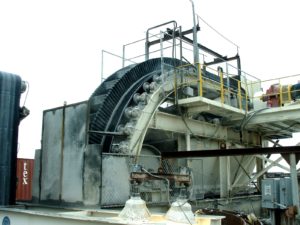 Excavation of the tunnel began on February 13, 2003. The tunnel was driven in two sections from a central launch shaft with an initial bore of 6.1 km (3.8 mi). After the initial drive, the head cutterhead support were hoisted out of the reception shaft. The rest of the machine was then reunited with the head and cutterhead support and taken back through the tunnel for the second 6.7 km (4.1 mi) drive.
Excavation of the tunnel began on February 13, 2003. The tunnel was driven in two sections from a central launch shaft with an initial bore of 6.1 km (3.8 mi). After the initial drive, the head cutterhead support were hoisted out of the reception shaft. The rest of the machine was then reunited with the head and cutterhead support and taken back through the tunnel for the second 6.7 km (4.1 mi) drive.
The machine executed both drives flawlessly. The TBM broke the world record for best advance in a single eight-hour shift at 45.75 m (150.1 ft), best advance in a day at 116.7 m (382.9 ft), and best advance in a week at 474.7 m (1,557 ft). It also broke the record for most rock excavated in 24 hours at 2,836.55 cu m (3,710 cu yd). The TBM holed through in February 2004.
Lesotho Highlands Water Project
Project Overview
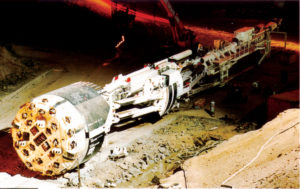 The Lesotho Highlands Water Project, a cooperative effort between Lesotho and South Africa, seeks to rejuvenate South Africa’s heavily populated and arid Gaucheng Province. It’s first phase began in 1992 and involved construction of the 180 m (590.5 ft) high Katse Dam, part of the Orange (Sequ) River system in Lesotho. The dam, finished in 1998, supplies water to South Africa’s Vaal river system via a water transfer tunnel and two delivery tunnels.
The Lesotho Highlands Water Project, a cooperative effort between Lesotho and South Africa, seeks to rejuvenate South Africa’s heavily populated and arid Gaucheng Province. It’s first phase began in 1992 and involved construction of the 180 m (590.5 ft) high Katse Dam, part of the Orange (Sequ) River system in Lesotho. The dam, finished in 1998, supplies water to South Africa’s Vaal river system via a water transfer tunnel and two delivery tunnels.
The two countries awarded the construction contract to the Lesotho Highlands Project Contractors (LHPC), a joint venture of Spie Batignolles (France), LTA Ltd. (South Africa), Ed Zublin AG (Germany), Balfour Beatty Ltd. (U.K.) and Campenon Bernard (France).
In 1991, LHPC contracted The Robbins Company to supply three new tunnel boring machines (TBMs) for the longer water transfer tunnel and one rebuilt TBM for the delivery tunnel. Two other TBMs from Atlas Copco and Wirth also participated in the dig.
Geology
The route of the water transfer tunnel passes through basaltic flows of volcanic rock. The area also includes some blocky conditions along faults and within doleritic dykes.
The south delivery tunnel passes through sedimentary rock, including the Clarens formation. This formation consists of horizontally layered siltstone and sandstone with occasional doleritic dykes and layers of claystone.
TBMs and Conveyors
Robbins supplied two new 5.03 m (16.5 ft) diameter Main Beam TBMs to excavate the 45.6 km (28.3 mi) water transfer tunnel. These machines were equipped with 35 disc cutters, all 17 inches (432 mm) in diameter. Both machines were designed with back-loading cutterheads which allowed for later installation of 19 inch (483mm) diameter cutters. The TBMs featured five 315 kW (422 hp) water-cooled motors that supplied 1,575 kW (2,111 hp) to the cutterhead.
An additional 5.18 m (17.0 ft) diameter TBM was deployed on the south delivery tunnel after being refurbished by Harrison Western Corp. The refitted Main Beam TBM featured 37 cutters all 17 inches (432mm) in diameter. The machine was powered by six 185 kW (248 hp) motors that provided 1,110 kW (1,489 hp) to the cutterhead.
Robbins built the 5.0 m (16.4 ft) diameter Mark-15, an open hard rock TBM, with 4 center cutters, 22 face cutters, and 8 gauge cutters, all 17 inches (432 mm) in diameter. Three 560 kW (751 hp) motors supplied 1,680 kW (2,253 hp) to the cutterhead and produced a torque of 1,588 kNm (1,171,523 lb-ft).
All four of the TBMs supplied were equipped with rock drill and trailing back-up systems.
Tunnel Excavation
 The first Main Beam TBM began boring the 17.4 km (10.8 mi) transfer tunnel section in June 1992 and set world tunneling records for its diameter class. It achieved a best day of 86.3 m (283.1 ft), a best week of 399.8 m (1,311.7 ft), and a best month of 1,344.3 m (4,410.4 ft). The TBM set these records despite challenging geology along the tunnel route. Rock jointing necessitated rock support measures, especially at the beginning of the drive. This support took up 24 percent of the total job time. The machine’s average rate of penetration was 4.59 m (15.1 ft) per hour and its average advance rate was 33.4 m (109.6 ft) per day. It broke through in September 1994.
The first Main Beam TBM began boring the 17.4 km (10.8 mi) transfer tunnel section in June 1992 and set world tunneling records for its diameter class. It achieved a best day of 86.3 m (283.1 ft), a best week of 399.8 m (1,311.7 ft), and a best month of 1,344.3 m (4,410.4 ft). The TBM set these records despite challenging geology along the tunnel route. Rock jointing necessitated rock support measures, especially at the beginning of the drive. This support took up 24 percent of the total job time. The machine’s average rate of penetration was 4.59 m (15.1 ft) per hour and its average advance rate was 33.4 m (109.6 ft) per day. It broke through in September 1994.
The second Main Beam TBM began its 17.3 km (10.7 mi) drive in July 1992. It achieved an average rate of penetration of 4.1 m (13.5 ft) per hour while maintaining average advance rates of 27.6 m (90.6 ft) per day and 620 m (2,034 ft) per month. The TBM turned in a superior performance with a best day advance of 66.8m (219.2 ft), a best week of 325 m (1,066 ft) and a best month of 1,221 m (4,006 ft).
The Mark 15 also began boring the water transfer tunnel in May 1992 and achieved breakthrough in September 1994. Difficult rock conditions slowed the boring and decreased the machine’s advance rate. Its best day was 62.9 m (206.4 ft), its average rate of penetration was 3.9 m (12.8 ft) per hour, its best week was 289 m (948 ft), and its best month was 987 m (3,238 ft). Rock support (i.e., bolting, rock straps, mesh, and concrete) took up about 15 percent of the total job time.
On October 13, 1994, the final Robbins TBM broke through ventilation shaft #3, completing excavation of the water transfer tunnel.
The refurbished Main beam TBM for the south delivery tunnel began boring in February 1992 and broke through 20 months ahead of schedule in August 1993. The TBM attained this feat in three drives of 2.1 km (1.3 mi), 5.2 km (3.2 mi), and 5.7 km (3.5 mi). Its average rate of penetration was 3.86 m (12.7 ft) per hour or 39.9 m (130.9 ft) per day (in three eight-hour shifts). The best day for the machine was 82 m (269 ft), the best week was 384 m (1,259.8 ft), and the best month was 1,324.4 m (4,345.1 ft).
Cobb County Sewer Tunnel
Project Overview
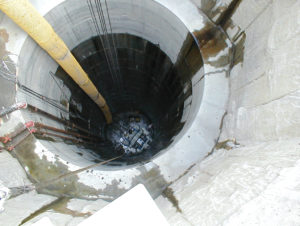 The Chattahoochee Sewer Tunnel is part of a project that meets increasing wastewater capacity needs in East Cobb County. The tunnel provides flow equalization to the RL Sutton Water Reclamation Facility and curbs potential wastewater overflows due to the growing population in Cobb County.
The Chattahoochee Sewer Tunnel is part of a project that meets increasing wastewater capacity needs in East Cobb County. The tunnel provides flow equalization to the RL Sutton Water Reclamation Facility and curbs potential wastewater overflows due to the growing population in Cobb County.
In 2000, project owner Cobb County Water Systems awarded the construction contract to the Gilbert-Healy Joint Venture. The contractors selected two 5.58 m (18.3 ft) diameter Robbins TBMs to bore a 14.6 km (9.1 mi) long section of the 15.3 km (9.5 mi) tunnel.
Geology
The geology of the Atlanta area consists of medium grade metamorphic rocks with some granitic rocks. Much of the rock includes gneiss, mica, and schist with an Unconfined Compressive Strength (UCS) of 150 – 230 MPa (22 – 33 ksi). These rocks have undergone intense weathering and erosion with some regional uplifting.
A key characteristic of the region is a thick layer of residual soil with a transition zone of soil and fractured rock underneath it. This geology posed groundwater problems for the tunnel because the soil zone is porous and water leaks into the fractured transition zone below. Faults in the bedrock can thus have very large water inflows.
Tunnel designers grappled with the difficult geology by pre-testing the rock along the tunnel area using packer tests. A section of rock was bored out and water was injected into the bore hole under pressure. In this way, bedrock permeability could be tested.
TBM
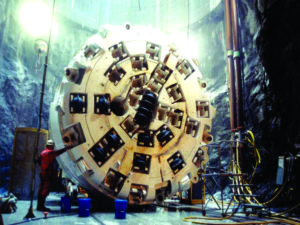 Robbins provided one new and one rebuilt TBM for the tunnels.
Robbins provided one new and one rebuilt TBM for the tunnels.
The new TBM for the South tunnel featured 19 inch (483 mm) cutters and generated up to 12,144 kN (2,730,000 lb) of cutterhead thrust. The machine was also capable of creating a cutterhead torque up to 2,082,885 N-m (1,536,257 lb-ft).
The rebuilt TBM for the North tunnel was completely redesigned for the project. The machine included 19 inch (483 mm) cutters and the same thrust and torque capacities of the South tunnel TBM.
Each machine was fitted with three rock drills — two behind the cutterhead to install rock bolts as well as one for drilling probe holes and pre-grouting holes to seal off any water inflows.
The conveyors, provided by Robbins, were continuous conveyors that ran along the tunnel as well as in the access shaft.
Tunnel Excavation
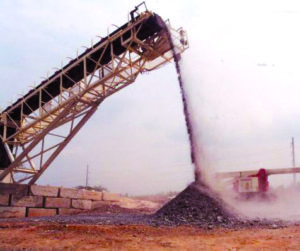 The TBM in the South tunnel began boring at the Elizabeth Lane shaft near the south end of the tunnel in August 2001 and finished in October 2002. The TBM experienced few problems and advanced 650 m (2,133 ft) in its first month of boring.
The TBM in the South tunnel began boring at the Elizabeth Lane shaft near the south end of the tunnel in August 2001 and finished in October 2002. The TBM experienced few problems and advanced 650 m (2,133 ft) in its first month of boring.
The TBM in the North tunnel began boring in November 2001 and finished in December 2002. It also experienced few problems and completed its task on time and within budget.
Pumping facilities in both the North and South Tunnels were capable of removing up to 18,000 liters (4,750 gallons) per minute, although the expected water inflows were much smaller — up to 1,800 liters ( 475 gallons) per minute. The pumping systems were precautionary and sufficient to control the water inflows encountered.
Тоннель в руднике Сан-Мануэль
О проекте
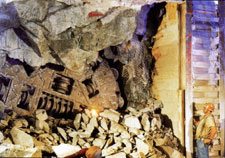
Тоннель в Сан Мануэль был построен, чтобы продлить жизнь руднику в Аризоне. Это один из самых больших в мире рудников, но согласно прогнозам, сделанным до постройки тоннеля, запасы руды должны были быть исчерпаны к 1998 году. Тоннель позволил подготовить к разработке рудное тело Нижний Каламазу, находящееся рядом с истощающимися рудными телами.
Заказчик, Magma Copper Company, подписал контракт на строительство тоннеля с совместным предприятием Frontier-Kemper Constructors Inc. и Deilmann-Haniel GmbH. Совместное предприятие выбрало для проходки открытую ТБМ Компании Роббинс диаметром 4,6 м.
Геология
Геологические условия рудного тела Нижний Каламазу весьма сложные. Здесь представлены рудные тела, порфиры и гранодиориты. Трасса тоннеля стречает многочисленные разломы и жилы: она проходит шесть раз через разлом San Manuel и пять раз – через разлом Virgin. Большие породные массивы были ослаблены гидротермальными проявлениями.
ТБМ
Компания Роббинс спроектировала новую скальную ТБМ открытого типа под конкретные геологические условия этого проекта. Чтобы помешать зажиму режущей головки при встрече с трещиноватой породой, машина может изменить направление вращения режущей головки. Для большей безопасности, ТБМ оснащена тридцатью тремя 17-дюймовыми шарошками задней загрузки.
Установленная мощность машины 1260 кВт, усилие главной подачи 8558 кН. Может быть достигнут момент вращения режущей головки в 2969911 Нм.
Кроме того, дополнительно установлены анкерустановщики и укладчик кольцевой шахтной крепи.
Защитовой комплекс имеет длину 120 м и состоит из 16 тележек на рельсовом ходу. Здесь расположено электрооборудование и системы контроля, гидравлический силовой блок и вспомогательное оборудование.
Порода загружается на ленточный конвейер защитового комплекса, после чего вывозиться тремя составами породных рудничных вагонеток. На путях имеется калифорнийская стрелка.
Проходка
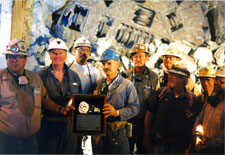
Бурение началось 11 ноября 1993 года из специально пройденной камеры с бетонной обделкой. Разлом San Manuel не создал больших проблем, но влажная глина разлома Virgin замедлила бурение. ТБМ продолжала встречать участки слабой глины и раздробленной породы.
Компания Роббинс с подрядчиками несколько модернизировали машину для увеличения скорости проходки. Они увеличили поток породы через режущую головку, увеличили её момент вращения и добавили дополнительное крепление тоннеля. После первых же модификаций производительность ТБМ значительно увеличилась. За первые 15 месяцев бурения суточная проходка утроилась и достигла величины 22,94 метра. Далее и до окончания бурения машина проходила в среднем 30 метров тоннеля в сутки.
Проходка оставалась в графике строительства и закончилась 4 декабря 1995 года.
Кабельный тоннель в Гонконге
О проекте
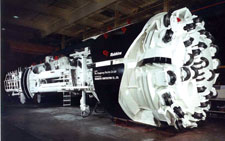
Кабельный тоннель на острове Гонконг используется дл подачи электроэнергии напряжением 275 кВ от электростанции на близлежащем острове Ламма. Шесть высоковольтных кабелей проложены в тоннеле длиной 5,4 км для электроснабжения жилых районов на западе острова Гонконг.
Заказчик проекта – гонконгская Электрическая Компания, поручила построить тоннель подрядчику Nishimatsu Construction Co. Nishimatsu выбрала для этого ТБМ открытого типа диаметром 4,8 метра. Ранее ТБМ в практике строительства на Гонконге не применялись.
Геология
В пяти местах тоннель пересекает три горных кряжа и проходит под водозабором водохранилища. Горные породы представлены гранитами и кварцами с присутствием некоторых вулканических пород, включающих крепкие туфы и лаву. Гонконгские граниты считаются одними из крепчайших в мире.
ТБМ
Компания Роббинс оборудовала высокопроизводительную машину тридцатью двумя 19-дюймовыми шарошками. Усилие главной подачи ТБМ – 10291 кН при мощности привода режущей головки 2275 кВт. Конструкций машины предусмотрены регулируемые боковые поддержки и гидравлические поддержки свода тоннеля, которые помогают стабилизации режущей головки и траектории движения шарошек. Большая величина заходки увеличивает время бурения в проходческом цикле и уменьшает время на перестановку захватов (грипперов).
Проходка
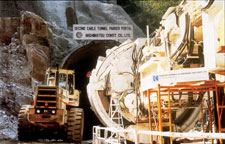
Проходка тоннеля началась в марте 1991 года. ТВМ продвигалась на уклоне в гранитном массиве. Водоприток потребовал устройства бетонного обратного свода и цементации трещин вдоль стен тоннеля.
Проходка зоны разлома Wong Nei Chung велась с некоторыми трудностями. Раздробленные и выветрелые граниты требовали крепления и опережающего разведочного бурения, что замедляло проходку. Немотря на это, производительность машины оставалась высокой за все ремя проходки, задержки отняли только 55 смен.
Машина закончила бурение тоннеля в октябре 1991 года, всего через 53 рабочие недели после начала проходки. Средняя недельная скорость проходки была 100 метров и средняя скорость подвижки забоя при бурении – 2,8 метра в час.
Seymour Capilano
Project Overview
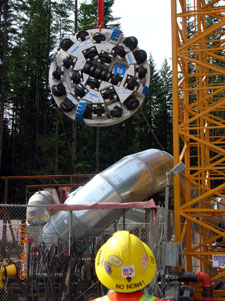 The Seymour-Capilano Water Filtration Project seeks to improve the filtration of drinking water in Vancouver, British Columbia. The completed filtration system will clean 1.8 billion liters (475.5 million gallons) of water a day and will lower the water turbidity (cloudiness) and micro-organism levels to meet federal standards for drinking water.
The Seymour-Capilano Water Filtration Project seeks to improve the filtration of drinking water in Vancouver, British Columbia. The completed filtration system will clean 1.8 billion liters (475.5 million gallons) of water a day and will lower the water turbidity (cloudiness) and micro-organism levels to meet federal standards for drinking water.
The project calls for twin tunnels, each 7.2 km (4.5 mi) long. The tunnels will transport untreated water from the Capilano reservoir to a filtration plant in the Lower Seymour Conservation Reserve and will return treated water to the Capilano reservoir for public consumption.
Geology
In 2004, the project owner, Greater Vancouver Regional District, awarded the construction contract to Germany-based Bilfinger Berger. The contractor chose two 3.8 m (12.5 ft) diameter Main Beam Robbins TBMs to bore the tunnels in intrusive granitic rock with strengths of 200 – 265 MPa (29 – 38 ksi).
TBM
Each TBM is outfitted with probe drills, to be used for the entire length of the tunnels. The probe drills probe ahead 40 m to check for pockets of underground water and verify the geology. The tunnel is unlined during excavation, but each machine is equipped with a ring beam erector to install full or partial beams depending on the geology.
Tunnel Excavation
The first of the two TBMs was delivered on May 18, 2006 and began boring on July 1, 2006. The second Robbins TBM was launched from the same shaft. Both machines were assembled in very short (60.5m/200ft and 70.5 m/230 ft) starter tunnels at the bottom of the 180 m (591 ft) shaft. Because of the short tunnel lengths, both TBMs excavated with their back-up systems partially constructed until they bored ahead 200 m (650 ft). The TBMs were assembled with only 11 decks of their respective 35 deck back-up systems.
After difficult ground conditions halted both TBMs for more than a year, excavation restarted in April 2009. New contractor, Frontier-Kemper/J.F. Shea/Aecon, restarted the machines and achieved advance rates of up to 29 m (95 ft) per day.
On November 4, 2010, the final breakthrough for the second of two Robbins TBMs capped more than two years of hard rock tunneling over a four year period. Frontier-Kemper successfully dealt with rocky conditions and some faulting using a program of rock bolts, wire mesh, and steel sets. Rock support varies from bare rock in good ground (Class I), to steel sets every 760 mm (30 in) in Class V poor rock.
The second Robbins TBM holed through at an angle into the other tunnel, where a chamber will now be built to conduct raise drilling of the 270 m (885 ft) deep Capilano shaft. Frontier-Kemper estimates that this work, combined with final shotcrete and steel lining in the tunnels, will take about two years.
San Vicente
Project Overview
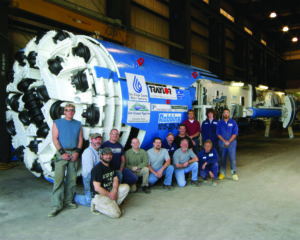 The San Vicente Pipeline, 17.7 km (11 mi) in length, connects the San Vicente Reservoir in Lakeside, California to the San Diego County Water Authority Second Aqueduct. The pipeline is part of the Water Authority’s Emergency Storage Project that will provide water to the city in the event of a drought or major earthquake.
The San Vicente Pipeline, 17.7 km (11 mi) in length, connects the San Vicente Reservoir in Lakeside, California to the San Diego County Water Authority Second Aqueduct. The pipeline is part of the Water Authority’s Emergency Storage Project that will provide water to the city in the event of a drought or major earthquake.
Project owner San Diego County Water Authority awarded the construction contract to the Traylor-Shea joint venture. The contractor chose a 3.5 m (11.5 ft) diameter Robbins Main Beam TBM and back-up system for two sections of tunnel at opposite ends, totaling about 2.75 km (1.70 mi) in length.
Geology
Due to the varying geology, multiple tunneling methods were chosen for the project. Two open-face digger shields were chosen to mine in conglomerates, while the TBM is mining in sections of rock at either end of the tunnel. The TBM-driven pass through granitic rock geology with a UCS of 140-345 MPa (2050 si).Drill and blast excavation is also being used in sections that interface the rock and conglomerate.
TBM
The refurbished TBM features 17 inch (432 mm) cutters and can generate a thrust of 6,005 kN (1,350,000 lb). The machine also has a maximum torque of 1,056,546 N-m (779,268 lb-ft) at the cutterhead. The Robbins back-up system consists of 11 decks and muck is being removed via muck cars.
Tunnel Excavation
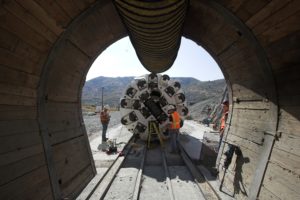 Boring began on June 21, 2006 after an onsite TBM assembly of only 30 working days. The machine excavated a 1.2 (0.7 mi) section west of the San Vicente Portal. and was then slated for an additional 400 m (1300 ft) section in weathered granite with clay seams. The Traylor-Shea JV slowed rotation of the cutterhead in order to bore through the mixed face and avoid clogging of the muck buckets. Excavation of the section using the TBM, rather than drill and blast, saved approximately 120 days on the construction schedule. The machine was then removed and re-launched at the West shaft where it will bore 1.3 km (0.8 mi) east. The machine excavated in granite requiring steel ribs and rock bolts, and completed its second section in April 2008.
Boring began on June 21, 2006 after an onsite TBM assembly of only 30 working days. The machine excavated a 1.2 (0.7 mi) section west of the San Vicente Portal. and was then slated for an additional 400 m (1300 ft) section in weathered granite with clay seams. The Traylor-Shea JV slowed rotation of the cutterhead in order to bore through the mixed face and avoid clogging of the muck buckets. Excavation of the section using the TBM, rather than drill and blast, saved approximately 120 days on the construction schedule. The machine was then removed and re-launched at the West shaft where it will bore 1.3 km (0.8 mi) east. The machine excavated in granite requiring steel ribs and rock bolts, and completed its second section in April 2008.
Plateau Creek
Project Overview
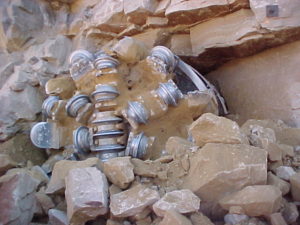 The Plateau Creek Pipeline was built to replace a pre-existing pipeline that supplied fresh water to rural and urban areas of Mesa County, Colorado, USA. The new tunnel provides water to 70,000 customers and has four times the hydraulic capacity of the old pipeline, which was unable to meet the District’s peak water demands.
The Plateau Creek Pipeline was built to replace a pre-existing pipeline that supplied fresh water to rural and urban areas of Mesa County, Colorado, USA. The new tunnel provides water to 70,000 customers and has four times the hydraulic capacity of the old pipeline, which was unable to meet the District’s peak water demands.
The project owner, UTE Water Conservancy District, awarded the construction contract for the entire 21 km (13 mi) pipeline to the Barnard-Affholder Joint Venture. Affholder was solely responsible for the two sections of tunnel that were bored by TBM. The contractor used a 3.3 m (10.8 ft) diameter Robbins Main Beam TBM to bore two tunnel lengths of 1.0 km (0.6 mi) and 3.1 km (1.9 mi).
Geology
The geology consists of sandstone, shale and siltstone with an Unconfined Compressive Strength (UCS) of 69 – 172 MPa (10 – 25 ksi). The rock required immediate support including rock bolts, wire mesh, and shotcrete.
TBM
Robbins rebuilt and modified the Affholder-owned Robbins Main Beam TBM specifically for the project. The machine had been a workhorse for Affholder, who has used the machine on nine different projects totaling over 30 km (19 mi) since purchasing the machine in 1993.
Modifications included a new cutterhead, cutterhead power increase by 25%, a new high capacity main bearing and a thrust increase to allow a loading of 267 kN (60,000 lb) per cutter. The machine was capable of up to 4,893 kN (1,100,000 lb) of cutterhead thrust and could generate up to 455,738 N-m (336,135 lb-ft) of torque at the cutterhead.
Tunnel Excavation
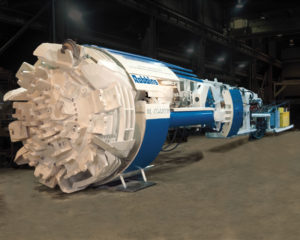 Boring began on the 1 km (0.6 mi) long tunnel in June 2000 and the machine holed through in August, just 1 month later. The machine was then disassembled and re-launched in only 2 weeks to bore the longer 3.1 km (1.9 mi) tunnel.
Boring began on the 1 km (0.6 mi) long tunnel in June 2000 and the machine holed through in August, just 1 month later. The machine was then disassembled and re-launched in only 2 weeks to bore the longer 3.1 km (1.9 mi) tunnel.
Excavation on the second tunnel began in September 2000. The machine set a world record in its size class on September 14th when it advanced 67 m (219 ft) in a single eight-hour shift. The TBM holed through ahead of schedule on March 16, 2001.

 Close
Close  Menu
Menu 